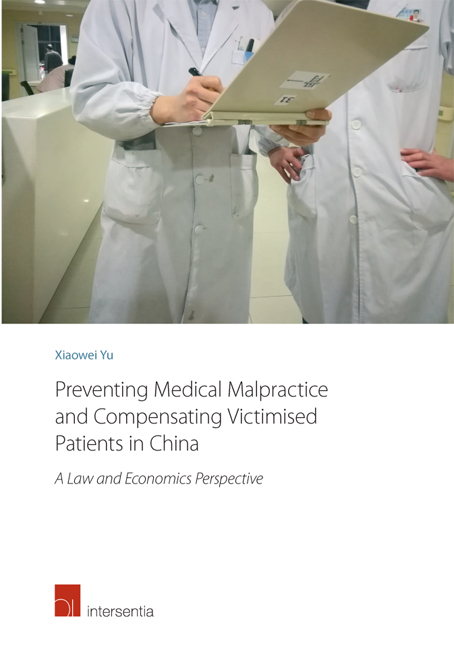 Preventing Medical Malpractice and Compensating Victimised Patients in China
Preventing Medical Malpractice and Compensating Victimised Patients in China Book contents
- Frontmatter
- Acknowledgements
- Contents
- Abbreviations
- List of Figures and Tables
- Chapter 1 Introduction
- Part I Legal Remedies for Medical Malpractice in China
- Part II Economic Theories and Empirical Evidence
- Introductory Note
- Chapter 7 Preventing Medical Errors through Tort Law – Theoretical Models
- Chapter 8 Preventing Medical Errors through Tort Law – Empirical Evidence and Updated Models
- Chapter 9 Preventing Medical Errors through Alternative Regimes
- Chapter 10 The Fault-Based Compensation Mechanisms for Iatrogenic Injuries
- Chapter 11 Medical Compensation Mechanisms Not Based on Fault
- Part III Applying the Economic Observations to China
- Summary
- Bibliography
- Appendix 1 Legislation
- Appendix 2 Cases
- Appendix 3 Semi-Structured Interviews
- Valorisation Addendum
- Curriculum Vitae
Chapter 10 - The Fault-Based Compensation Mechanisms for Iatrogenic Injuries
from Part II - Economic Theories and Empirical Evidence
Published online by Cambridge University Press: 29 September 2018
- Frontmatter
- Acknowledgements
- Contents
- Abbreviations
- List of Figures and Tables
- Chapter 1 Introduction
- Part I Legal Remedies for Medical Malpractice in China
- Part II Economic Theories and Empirical Evidence
- Introductory Note
- Chapter 7 Preventing Medical Errors through Tort Law – Theoretical Models
- Chapter 8 Preventing Medical Errors through Tort Law – Empirical Evidence and Updated Models
- Chapter 9 Preventing Medical Errors through Alternative Regimes
- Chapter 10 The Fault-Based Compensation Mechanisms for Iatrogenic Injuries
- Chapter 11 Medical Compensation Mechanisms Not Based on Fault
- Part III Applying the Economic Observations to China
- Summary
- Bibliography
- Appendix 1 Legislation
- Appendix 2 Cases
- Appendix 3 Semi-Structured Interviews
- Valorisation Addendum
- Curriculum Vitae
Summary
INTRODUCTION
Unlike the previous three chapters (7-9) where particular attention is paid to prevention of medical malpractice (primary and tertiary cost avoidance), this chapter (and also the next) is intended to answer Sub-question (2-a) from the perspective of compensation (secondary cost avoidance). While this chapter is concerned only with the fault-based compensation mechanisms (tort law alone, the fault-liability-insurance system, and self-insurance), the next Chapter 11 will deal with compensation instruments that are not based on fault (first-party insurance, no-fault compensation funds, and social security).
Secondary costs are defined as “the social dislocation costs of the accident,” “the costs of social and economic dislocations which all too often follow the immediate accident, especially if the initial cost burden is left unspread,” or simply “the societal costs resulting from accidents.” Although the secondary goal is sometimes referred to as compensation, it is different from the legal notion of “corrective compensation.” According to Calabresi, not only the costs of accident reduction should be reduced in the first place, but the secondary costs resulting from accidents which nonetheless occur need to be reduced as well. However, the pursuit of secondary cost reduction may adversely affect the primary goal of accident law. The preventive incentives generated by tort liability may be diluted by the presence of various compensation instruments. Hence, the issues of prevention and compensation are often intertwined.
In addition, the benefits of primary and secondary cost avoidance must be counter-balanced by tertiary costs – “those costs involved in regulating primary and secondary costs.” In practice, tertiary costs may include litigation costs and the costs of operating courts and prisons, regulatory bodies, and various institutions that are in charge of risk spreading (e.g. costs incurred by insurance companies when investigating the damage). The goal of tertiary cost reduction is equally important because if primary or secondary cost reduction “costs more than it saves,” there will be a waste of scarce social resources. Social optimum will be obtained if the sum of all the three costs, together with the costs of precaution, is minimised.
There are many instruments that can be employed to compensate victims of medical malpractice. This Chapter will focus on compensation via tort law, liability insurance, and self-insurance. All these instruments are fault-based. No-fault compensation mechanisms (first-party insurance, compensation funds, and social security) will be addressed in Chapter 11.
- Type
- Chapter
- Information
- Preventing Medical Malpractice and Compensating Victimised Patients in ChinaA Law and Economics Perspective, pp. 351 - 398Publisher: IntersentiaPrint publication year: 2017
